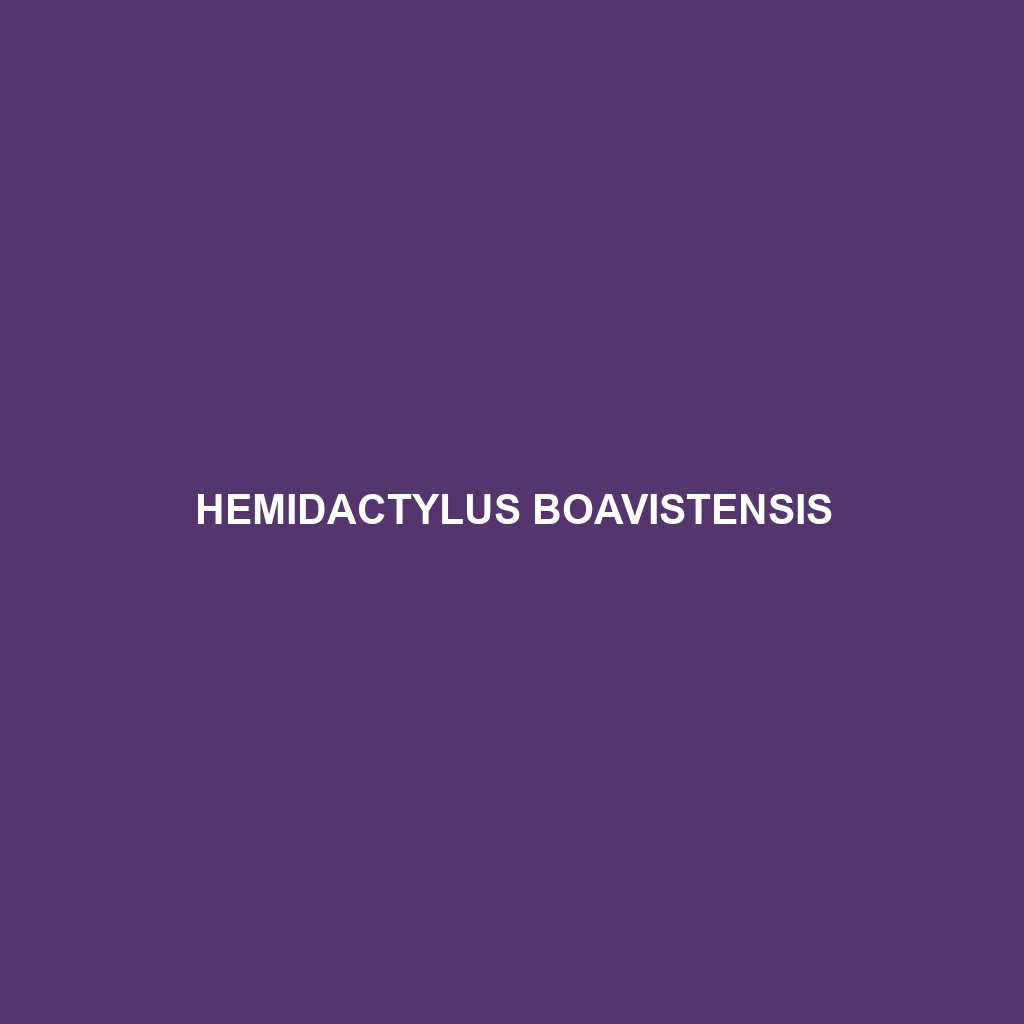Common Name
Hemidactylus boavistensis
Scientific Name
Hemidactylus boavistensis
Habitat
The Hemidactylus boavistensis, commonly known as the Boa Vista gecko, primarily inhabits the diverse ecosystems of the Cape Verde archipelago, particularly on the islands of Boa Vista and Sal. This species thrives in a variety of habitats including coastal zones, scrublands, and semi-arid regions that feature a blend of rocky outcrops and sandy terrains. The climate in these areas is predominantly tropical, with warm temperatures and a distinct dry season. These geckos are often found in areas with considerable vegetation, which provides them with shelter and hunting grounds, making ‘savannas’, ‘marine habitats’, and ‘tropical ecosystems’ ideal locales for the species. Understanding their habitat preferences is crucial for conservation efforts and ecological studies.
Physical Characteristics
Hemidactylus boavistensis is a medium-sized gecko, typically measuring between 10 to 15 cm in length. The body is characterized by a flattened shape, allowing it to navigate through small crevices and rocky terrains easily. Its skin is predominantly sandy brown, with darker spots that provide camouflage against its natural environment. One of the distinguishing features of this species is its large, adhesive toe pads which enhance its climbing abilities, making it adept at moving vertically on surfaces. The eyes, large and expressive, are adapted for low-light predation, indicative of its nocturnal habits.
Behavior
In terms of behavior, Hemidactylus boavistensis exhibits primarily nocturnal habits, becoming active during the night to hunt and socialize. These geckos are typically solitary but may be seen in small groups during social interactions, particularly during the mating season. They are known for their territorial displays, which include vocalizations and displays of physical prowess, asserting their dominance to potential rivals. Mating rituals involve elaborate courtship behaviors where males will present themselves through head bobbing and tail waving to attract females. The ability to camouflage effectively during the day allows them to avoid predators and remain hidden from sight.
Diet
The dietary habits of Hemidactylus boavistensis classify it as an insectivore. The primary food sources include a variety of insects such as moths, crickets, and beetles, which they capture using their swift reflexes and agility. They hunt primarily at night, using their excellent vision to detect movement in low-light conditions. Their diet may also be supplemented with other small invertebrates, showcasing their adaptability as predators. Understanding their feeding patterns is crucial for recognizing their ecological role within their habitat.
Reproduction
The reproductive cycle of Hemidactylus boavistensis is characterized by seasonal mating, typically occurring during the warmer months when food is abundant. The gestation period lasts approximately 30-40 days, after which the females lay a clutch of two to three eggs in a sheltered location. The eggs are often deposited in crevices or under loose debris, providing some protection from potential predators. Parental care is minimal; however, the eggs benefit from the temperate environment of the islands that helps in the incubation process. The hatchlings are independent from birth and quickly adapt to their surroundings.
Conservation Status
Currently, Hemidactylus boavistensis is classified as ‘Least Concern’ according to the International Union for Conservation of Nature (IUCN). However, the species faces threats from habitat loss due to urbanization and climate change. Conservation efforts focus on habitat preservation and monitoring population trends to ensure this species continues to thrive in its natural environment. Awareness campaigns and ecological studies aim to protect the habitats vital for their survival, ensuring that they remain a stable component of the Cape Verde fauna.
Interesting Facts
One intriguing fact about Hemidactylus boavistensis is its remarkable ability to regenerate its tail if lost, an adaptive trait that serves as a defense mechanism against predators. The new tail, although differing in appearance from the original, provides a means for the gecko to escape encounters with potential threats. Additionally, this species plays a significant role in controlling insect populations, showcasing its importance in maintaining ecological balance.
Role in Ecosystem
The ecological role of Hemidactylus boavistensis is vital as it acts as both a predator and prey within its habitat. As an insectivore, it helps regulate insect populations, contributing to the health of the ecosystem. Furthermore, this gecko serves as a food source for various local predators, including birds and larger reptiles. Its presence indicates a healthy environment, and it plays a crucial part in the food web, demonstrating the interconnectedness of species within the Cape Verde islands.
